Hanwha Systems Bundle
How Does Hanwha Systems Stack Up in Today's Tech-Driven Defense Market?
The defense and IT sectors are undergoing a massive transformation, fueled by cutting-edge technologies like AI and cybersecurity. Hanwha Systems, a key player originally from South Korea, has evolved from precision machinery to a global leader in smart technologies. This evolution has positioned them strategically in a fiercely competitive environment. This analysis dives deep into the Hanwha Systems SWOT Analysis and competitive landscape.
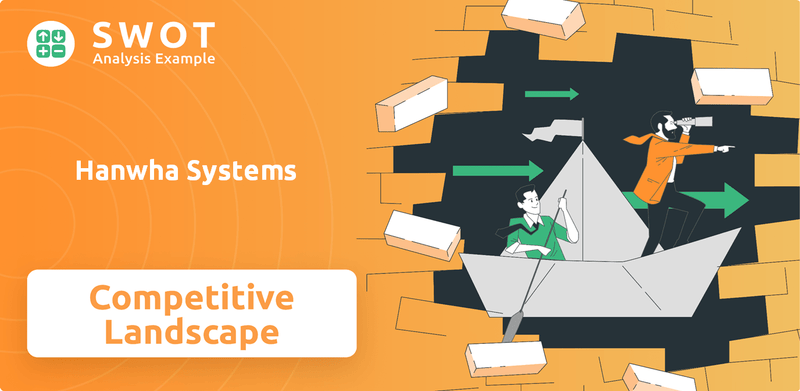
Understanding the Hanwha Systems competitive landscape is crucial for investors and strategists alike. This report provides a detailed market analysis, examining Hanwha Systems' key rivals and competitive advantages within the Hanwha Systems industry. We'll explore their business strategy, including recent acquisitions and strategic partnerships, to assess their strengths and weaknesses. Furthermore, we'll analyze Hanwha Systems' future growth potential and its market position in radar systems and the drone market, considering the impact of global events on competition.
Where Does Hanwha Systems’ Stand in the Current Market?
Hanwha Systems holds a significant market position, particularly in the defense electronics and IT services sectors. The company is a recognized leader in defense electronics, excelling in areas like radar systems, electro-optics, and C4I solutions. Its core operations revolve around these advanced technologies and IT solutions, serving both domestic and international markets.
The company's value proposition lies in its ability to provide cutting-edge defense systems and IT services. This includes advanced radar systems, combat management systems, and digital transformation solutions. Hanwha Systems focuses on innovation and technological advancement to meet the evolving needs of its customers, including government agencies and private enterprises. For a deeper dive into the company's ownership structure, consider reading about Owners & Shareholders of Hanwha Systems.
Hanwha Systems reported consolidated revenue of KRW 2.45 trillion in 2023. This financial performance highlights its robust position in the industry. The company continually invests in research and development to maintain its competitive edge.
Hanwha Systems maintains a strong market position in the defense electronics and IT services industries. While specific market share figures for 2024-2025 are proprietary, the company's leadership in defense electronics is well-established. Its focus on advanced radar systems and combat management systems contributes significantly to its market presence.
The company's primary market is South Korea, where it benefits from significant domestic defense contracts. Hanwha Systems is actively expanding its international footprint, particularly in the Middle East and Southeast Asia. This expansion is a strategic move to diversify revenue streams beyond the domestic market.
Hanwha Systems offers a diverse product portfolio, including advanced radar systems, combat management systems, and naval combat systems. It also provides IT solutions for digital transformation, smart factory implementation, and enterprise resource planning. These offerings cater to a wide range of customers, including government agencies and private enterprises.
In 2023, Hanwha Systems reported a consolidated revenue of KRW 2.45 trillion, demonstrating its financial strength. The company consistently invests in research and development to maintain its technological edge. These investments are crucial for sustaining its competitive advantage in the market.
Hanwha Systems' strengths include its strong position in the South Korean defense market and its technological expertise in radar and naval systems. The company's focus on R&D and its expanding international presence are also significant advantages. These factors contribute to its ability to compete effectively in the defense and IT sectors.
- Strong domestic market presence in South Korea.
- Technological leadership in radar and naval systems.
- Increasing international footprint and export deals.
- Consistent R&D investments for innovation.
Hanwha Systems SWOT Analysis
- Complete SWOT Breakdown
- Fully Customizable
- Editable in Excel & Word
- Professional Formatting
- Investor-Ready Format
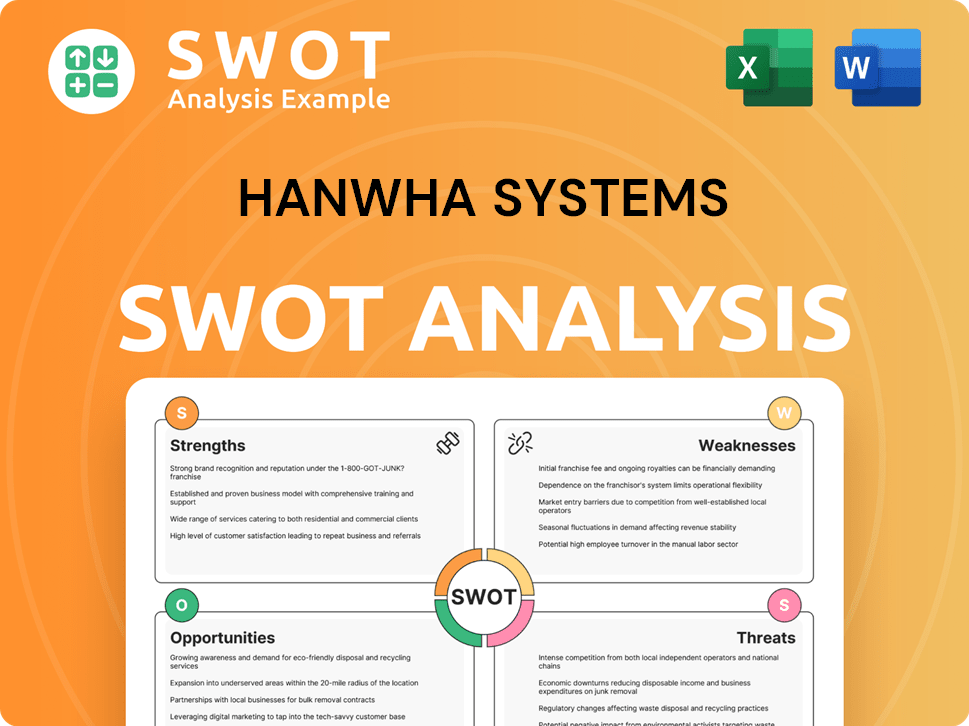
Who Are the Main Competitors Challenging Hanwha Systems?
The Hanwha Systems competitive landscape is complex, encompassing both direct and indirect rivals across its defense and IT services sectors. Understanding the key players and their strategies is crucial for evaluating its market position and future prospects. A thorough Hanwha Systems market analysis reveals the competitive dynamics shaping its growth.
Hanwha Systems' business strategy is significantly influenced by the competitive environment. The company faces challenges from established global defense contractors and domestic IT service providers. Analyzing Hanwha Systems competitors helps to understand the pressures and opportunities it encounters.
Key direct competitors in the defense electronics sector include Lockheed Martin, Raytheon Technologies, BAE Systems, and Northrop Grumman. These companies offer comprehensive defense solutions, competing directly with Hanwha Systems in areas like radar systems and electronic warfare. For instance, Raytheon's advanced radar technologies are a direct competitor.
Domestically, LIG Nex1 is a significant rival, competing across various defense electronics segments, including precision-guided munitions and surveillance systems. This rivalry is particularly intense within the South Korean market. A comparison of Hanwha Systems vs LIG Nex1 reveals their respective strengths.
In the IT services domain, Hanwha Systems competes with major IT service providers like Samsung SDS, LG CNS, and SK C&C in South Korea. These companies offer similar digital transformation, smart factory, and cloud computing solutions. They challenge Hanwha Systems through aggressive pricing and extensive service portfolios.
Emerging players in specialized areas, such as cybersecurity startups or AI-driven analytics firms, also represent indirect competition. These firms offer niche solutions that could integrate into or disrupt traditional defense and IT frameworks. This indirect competition adds another layer of complexity to the Hanwha Systems industry.
Mergers and alliances within the global defense industry intensify the competitive landscape. Larger entities gain broader capabilities and market reach, increasing the pressure on Hanwha Systems. This consolidation impacts the company's strategic partnerships and collaborations.
Hanwha Systems' market position in radar systems is a key area of competition. The company's radar technology competes with offerings from major defense contractors. Analyzing the competitive landscape in radar systems is crucial for understanding Hanwha Systems' competitive advantages.
The competitive environment necessitates a robust Hanwha Systems business strategy. The company must continuously innovate and adapt to maintain its market position. Understanding the Hanwha Systems' future growth potential analysis requires a deep dive into these competitive dynamics.
- Hanwha Systems faces intense competition from global defense giants with extensive R&D budgets. For example, Lockheed Martin's R&D spending was approximately $13.7 billion in 2023.
- Domestic rivals like LIG Nex1 pose a significant threat, especially in the South Korean market. LIG Nex1's revenue in 2023 was around ₩2.2 trillion (approximately $1.6 billion).
- The IT services sector sees competition from major players like Samsung SDS, which reported revenues of ₩13.7 trillion (around $10.2 billion) in 2023.
- Emerging technologies and the impact of global events further complicate the Hanwha Systems competitive environment in the defense sector.
- For further insights, consider reading the Growth Strategy of Hanwha Systems.
Hanwha Systems PESTLE Analysis
- Covers All 6 PESTLE Categories
- No Research Needed – Save Hours of Work
- Built by Experts, Trusted by Consultants
- Instant Download, Ready to Use
- 100% Editable, Fully Customizable
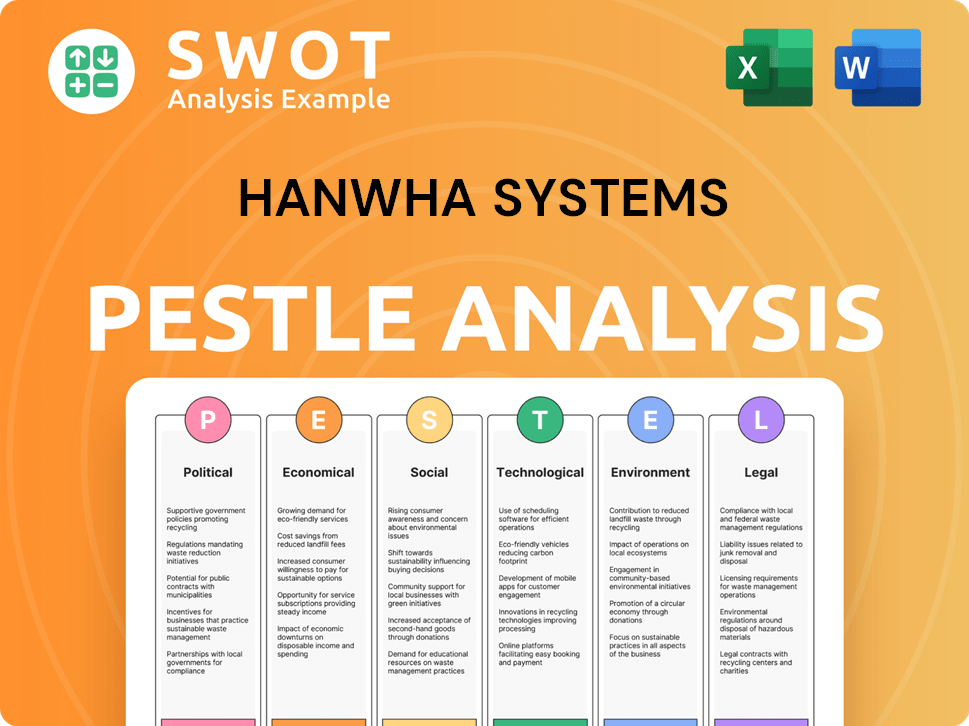
What Gives Hanwha Systems a Competitive Edge Over Its Rivals?
Understanding the Hanwha Systems competitive landscape requires a deep dive into its core strengths. The company's technological prowess, especially in radar systems and AI-based surveillance, sets it apart. Its ability to deliver comprehensive solutions, integrating both hardware and software, provides a significant edge in the Hanwha Systems industry.
Hanwha Systems has a strong focus on research and development, which is a key driver of its competitive advantage. This commitment to innovation ensures a continuous flow of new products and technologies. The backing of the Hanwha Group provides financial stability and access to a broader network, supporting its strategic initiatives.
Examining Hanwha Systems' business strategy reveals a commitment to integrated solutions and technological innovation. This approach allows the company to offer comprehensive services that enhance interoperability and system efficiency for its clients. The company's forward-looking strategy, including advancements in urban air mobility (UAM) and space exploration, demonstrates its commitment to staying ahead of the curve. To learn more about the company's origins, you can read a Brief History of Hanwha Systems.
Hanwha Systems excels in radar systems, particularly AESA radars, vital for next-generation defense applications. Its investment in AI-based surveillance and satellite communication further strengthens its market position. This technological advantage is a cornerstone of its competitive edge in the Hanwha Systems market analysis.
The company's ability to provide complete solutions in C4I, surveillance, and electronic warfare is a key differentiator. This integrated approach enhances system efficiency and interoperability. This comprehensive offering sets Hanwha Systems apart from competitors in the Hanwha Systems competitive landscape.
Hanwha Systems consistently invests a significant portion of its revenue in R&D. Recent advancements in UAM and space technologies highlight its forward-looking strategy. This continuous innovation pipeline is crucial for maintaining its competitive position in the defense sector.
Backed by the Hanwha Group, the company benefits from financial stability and a wide network. This support enables strategic partnerships and international market expansion. This financial backing is a key factor in its ability to compete effectively in the global market.
Hanwha Systems' competitive advantages include advanced technology, integrated solutions, and strong financial backing. However, it faces challenges from rapid technological obsolescence and aggressive R&D by global competitors. Its consistent investment in R&D, with a significant portion of its revenue allocated to developing new technologies, ensures a continuous pipeline of innovative products.
- Competitive Advantages: Advanced radar systems, integrated solutions, strong financial backing.
- Challenges: Rapid technological changes, aggressive competition.
- Strategic Focus: Continuous R&D, international market expansion.
- Market Position: Strong in radar systems and integrated defense solutions.
Hanwha Systems Business Model Canvas
- Complete 9-Block Business Model Canvas
- Effortlessly Communicate Your Business Strategy
- Investor-Ready BMC Format
- 100% Editable and Customizable
- Clear and Structured Layout
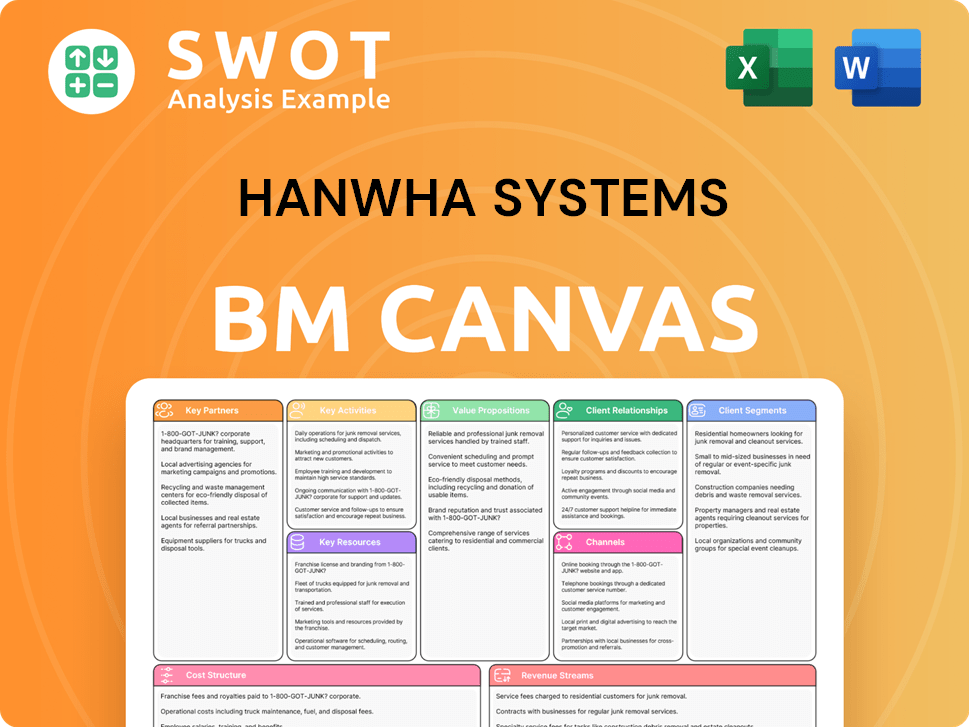
What Industry Trends Are Reshaping Hanwha Systems’s Competitive Landscape?
The defense and IT sectors are undergoing significant transformation, influencing the Hanwha Systems competitive landscape. Technological advancements, regulatory changes, and geopolitical dynamics are key drivers. These factors present both challenges and opportunities for companies like Hanwha Systems, requiring strategic adaptation and innovation.
Analyzing the Hanwha Systems industry involves understanding its position amidst global trends and rival activities. This analysis is crucial for investors and strategists assessing the company's potential. Understanding the competitive environment helps in making informed decisions about its future.
The defense sector is seeing increased demand for advanced technologies like AI and quantum computing. Regulatory scrutiny on defense exports and cybersecurity is rising. Global conflicts are boosting defense spending, creating market opportunities.
Keeping pace with rapid technological advancements requires significant R&D investment. Cybersecurity threats to defense infrastructure necessitate continuous investment. New entrants with disruptive technologies may challenge traditional business models.
The demand for integrated defense solutions aligns with Hanwha Systems' core competencies. Expansion into emerging markets offers substantial growth potential. Opportunities exist in future mobility, including urban air mobility (UAM) and satellite internet services.
Strategic partnerships and collaborations with global technology leaders are crucial. Investing in R&D to stay ahead of technological advancements is critical. Focusing on cybersecurity solutions is essential to protect assets and data.
To maintain a strong position, Hanwha Systems needs to adapt its business strategy. This involves investing in innovation and forming strategic partnerships. For more insights into the company's approach, consider reading about the Marketing Strategy of Hanwha Systems. This adaptability is crucial for navigating the evolving Hanwha Systems competitive landscape and securing its future in the defense and IT sectors.
The defense industry is expected to grow, driven by geopolitical instability and technological advancements. Cybersecurity threats are increasing, necessitating robust solutions. Strategic partnerships and innovation are vital for success.
- Hanwha Systems should focus on R&D to stay ahead of technological advancements.
- Expanding into emerging markets like Asia and the Middle East offers growth potential.
- Continuous investment in cybersecurity is essential to protect assets and data.
- Strategic collaborations with global technology leaders will enhance competitiveness.
Hanwha Systems Porter's Five Forces Analysis
- Covers All 5 Competitive Forces in Detail
- Structured for Consultants, Students, and Founders
- 100% Editable in Microsoft Word & Excel
- Instant Digital Download – Use Immediately
- Compatible with Mac & PC – Fully Unlocked
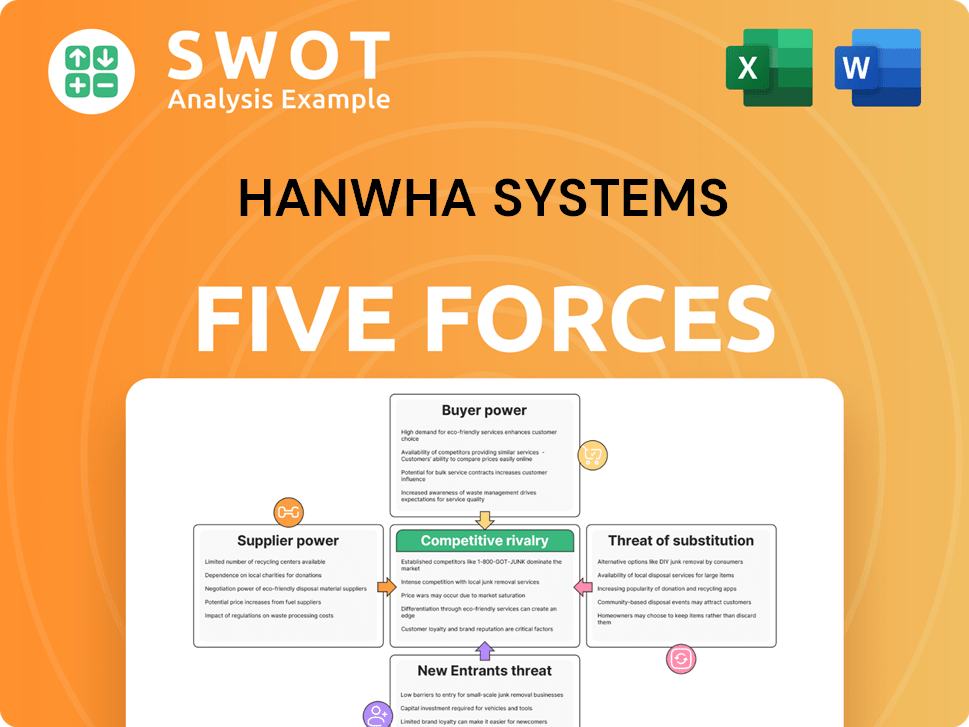
Related Blogs
- What are Mission Vision & Core Values of Hanwha Systems Company?
- What is Growth Strategy and Future Prospects of Hanwha Systems Company?
- How Does Hanwha Systems Company Work?
- What is Sales and Marketing Strategy of Hanwha Systems Company?
- What is Brief History of Hanwha Systems Company?
- Who Owns Hanwha Systems Company?
- What is Customer Demographics and Target Market of Hanwha Systems Company?
Disclaimer
All information, articles, and product details provided on this website are for general informational and educational purposes only. We do not claim any ownership over, nor do we intend to infringe upon, any trademarks, copyrights, logos, brand names, or other intellectual property mentioned or depicted on this site. Such intellectual property remains the property of its respective owners, and any references here are made solely for identification or informational purposes, without implying any affiliation, endorsement, or partnership.
We make no representations or warranties, express or implied, regarding the accuracy, completeness, or suitability of any content or products presented. Nothing on this website should be construed as legal, tax, investment, financial, medical, or other professional advice. In addition, no part of this site—including articles or product references—constitutes a solicitation, recommendation, endorsement, advertisement, or offer to buy or sell any securities, franchises, or other financial instruments, particularly in jurisdictions where such activity would be unlawful.
All content is of a general nature and may not address the specific circumstances of any individual or entity. It is not a substitute for professional advice or services. Any actions you take based on the information provided here are strictly at your own risk. You accept full responsibility for any decisions or outcomes arising from your use of this website and agree to release us from any liability in connection with your use of, or reliance upon, the content or products found herein.